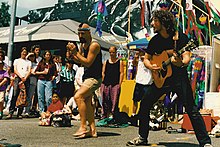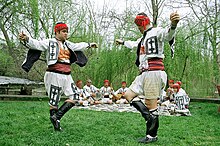Spoon (musical instrument)
As a percussion instrument used spoons belong to their tone - if they are paired against each hit - to the counter-attack idiophones , so rattling , and - if they are beaten against a non-sounding body - to the Aufschlagidiophonen. Metal or wood spoons are used in different ways in many cultures. They are mainly used in folk music and to accompany dance. Their sound is metallic or similar to that of castanets .
Playing technique
In Europe, Canada and the United States, two common household spoons or wooden spoons are used, the handles of which are wedged between the thumb, forefinger and middle finger of one hand so that the convex surfaces are positioned a short distance from one another. If the player hits the other hand, a thigh or another part of the body, the spoons hit each other. Some spoon players use two pairs of spoons at the same time, holding one pair in the right hand and the other pair in the left hand.
In traditional Russian music, three spoons are mostly used, with one spoon struck against two others.
sound
The sound of the spoons depends on several factors. On the one hand, the material from which the spoons are made determines the sound properties. The metal spoons sound harder and lighter than the wooden spoons. With the wooden spoons, the type of wood is one of the decisive factors for the sound. On the other hand, the sound depends on the technique of the player. So you can create a light and open or a dark and muffled sound, especially with the wooden spoons. The spoon size also determines the tonal character.
distribution

Spoons as a musical instrument are common in Russian folk music under the name loschki (Russian Ло́жки, English transcription lozhky ). The farmers used them to accompany singing as early as the 18th century. Spoons were mostly misappropriated at feasts and used as a percussion instrument on the whim. From the 19th century onwards, spoons specially designed for making music were made. These were used in the folklore singing and instrumental ensembles of Russia . In Lithuania the spoons are called saukstai .
In Ireland , wooden or metal spoons are played with enormous speed in folk music. Traditionally, spoons and bones ( bones played in pairs) as well as the Irish frame drum bodhrán appear as rhythmic accompanying instruments.
Along with a Jew's harp (French guimbarde ) are spoon in Canada often used as rhythm instruments with traditional dances. They accompany a solo fiddle and the chorus sung in the choir on older folk songs.
In the rural Turkish people music spoons ( Kaşık , plural kaşıklar ) usually pairs of wood in each hand to dance accompaniment played, partly as a single rhythm instrument or in connection with the frame drum davul . The Turkish spoons are held at the top with the stems sticking out between the fingers of the clenched hands. Wooden spoons are mainly used in western central Anatolia for "spoon dances" ( kaşık oyunları ) and occasionally for the Zeybek dances that are widespread on the Aegean coast . Spoons have disappeared from urban Turkish popular music today. From the 16th to the 18th century, spoons were common, the Turkish name çarpara from the Persian chahār para ("four parts") derived. In Persian sources, chahār para have been depicted since the 12th century, the shape and function of which correspond approximately to the Indian karatāla (derived from the ancient crotales ), the Turkish dervish rattles chalpara or the qarāqib in the Maghreb .
The Turkish word for spoon, kaşık , occurs in the Bosnian language as kašike and žlice . In Bosnia the spoons used to accompany the dance are made of metal and equipped with small bells. The player holds a spoon in each hand and hits them with the curved sides.
Spoons are also found in American folk music. In a few old Indonesian gamelans , a spoon-like bronze percussion idiophone called a kemanak is used, which consists of a sheet of metal rolled up into a tube and which, according to its shape , can be counted among the slotted drums . On the island of Java the kemanak are curved in the shape of a banana, on Bali they are slightly smaller and straight.
In the volksmusik (Alpenländisches spoon beating) or about the Löffelpolka spoon be used. There are special wooden music spoons that are connected to each other at the end of the handle and that are either made by yourself or bought in music stores.
The Vietnamese occasionally play metal household spoons (Vietnamese muỗng ) or one-piece musical spoons. On the Polynesian Marquesas Islands, spoons are used as a kind of vessel rattle , in addition to the European way of playing . The player shakes a bottle with two metal spoons ( tuita ) stuck in the neck .
Web links
literature
- Dorit Klebe: Spoon dances from Silifke. Silifke Kaşik Oyunlari. Supplement to the film (series of working papers). Pedagogical Center, Berlin 1985
- Laurence Libin: Spoon. In: Laurence Libin (Ed.): The Grove Dictionary of Musical Instruments. Vol. 4, Oxford University Press, Oxford / New York 2014, p. 603
Individual evidence
- ↑ Irish Spoon Player Johnny Bongos Horgan. Youtube video
- ↑ Jay Rahn: Canada. II. Traditional music. 3. Immigrant traditions. (ii) British and Irish. (b) Instrumental music and dance. In: Grove Music Online , 2001
- ↑ Şimşir Kaşık - Müzik aletleri. Youtube video (hand position Turkish spoon)
- ↑ Laurence Picken : Folk Musical Instruments of Turkey. Oxford University Press, London 1975, pp. 7-10, 15f
- ↑ Kaşık. In: Laurence Libin (Ed.): The Grove Dictionary of Musical Instruments. Vol. 3, Oxford University Press, Oxford / New York 2014, p. 117
- ↑ Meeting of 2 Kings of Spoons: Roger Mason & Tran Quang Hai. Youtube video
- ↑ Jane Freeman Moulin: Music of the Southern Marquesas Islands. Occasional Papers in Pacific Ethnomusicology, No. 3, 1994, p. 24

